The SSD Improv: Intel & Indilinx get TRIM, Kingston Brings Intel Down to $115
by Anand Lal Shimpi on November 17, 2009 7:00 PM EST- Posted in
- Storage
Overall System Performance using PCMark Vantage
Next up is PCMark Vantage, another system-wide performance suite. For those of you who aren’t familiar with PCMark Vantage, it ends up being the most real-world-like hard drive test I can come up with. It runs things like application launches, file searches, web browsing, contacts searching, video playback, photo editing and other completely mundane but real-world tasks. I’ve described the benchmark in great detail before but if you’d like to read up on what it does in particular, take a look at Futuremark’s whitepaper on the benchmark; it’s not perfect, but it’s good enough to be a member of a comprehensive storage benchmark suite. Any performance impacts here would most likely be reflected in the real world.
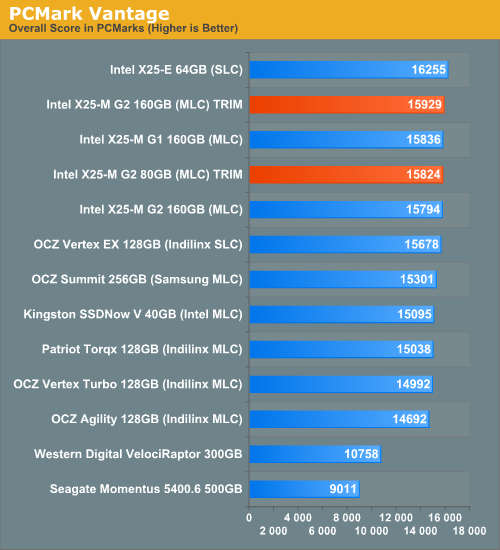
The overall impact of the TRIM firmware is negligable, no real improvements here - something you'll see echoed in nearly all of the PCMark results. The 40GB Kingston drive does well for its price, delivering performance similar to an Indilinx drive as it is crippled by a small amount of free space.
The memories suite includes a test involving importing pictures into Windows Photo Gallery and editing them, a fairly benign task that easily falls into the category of being very influenced by disk performance.
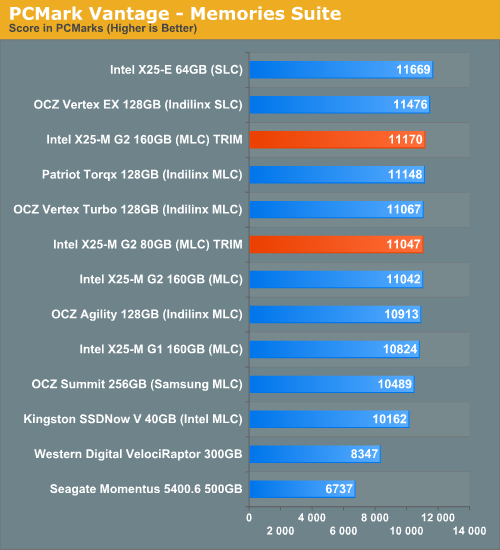
The TV and Movies tests focus on on video transcoding which is mostly CPU bound, but one of the tests involves Windows Media Center which tends to be disk bound.

The gaming tests are very well suited to SSDs since they spend a good portion of their time focusing on reading textures and loading level data. All of the SSDs dominate here, but as you'll see later on in my gaming tests the benefits of an SSD really vary depending on the game. Take these results as a best case scenario of what can happen, not the norm.
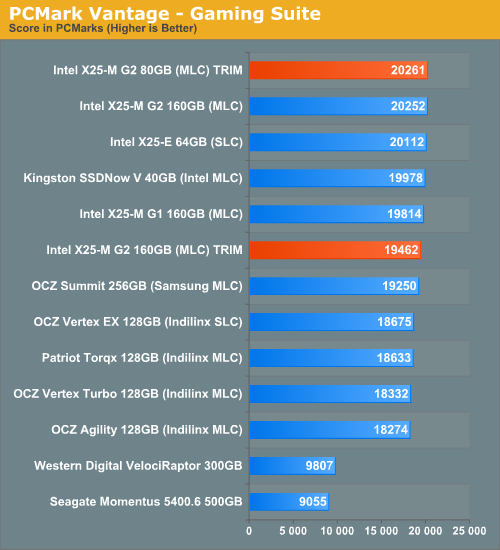
In the Music suite the main test is a multitasking scenario: the test simulates surfing the web in IE7, transcoding an audio file and adding music to Windows Media Player (the most disk intensive portion of the test).
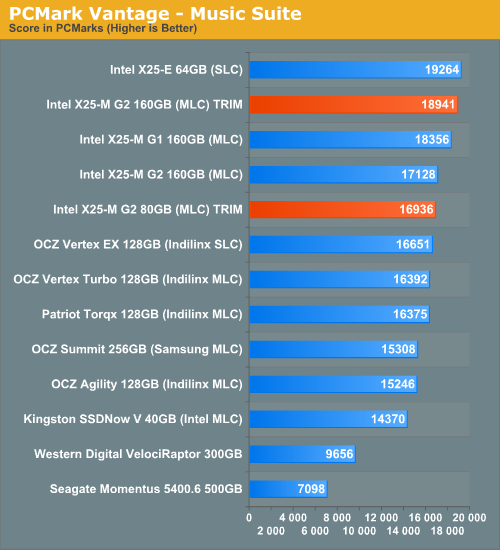
The Communications suite is made up of two tests, both involving light multitasking. The first test simulates data encryption/decryption while running message rules in Windows Mail. The second test simulates web surfing (including opening/closing tabs) in IE7, data decryption and running Windows Defender.
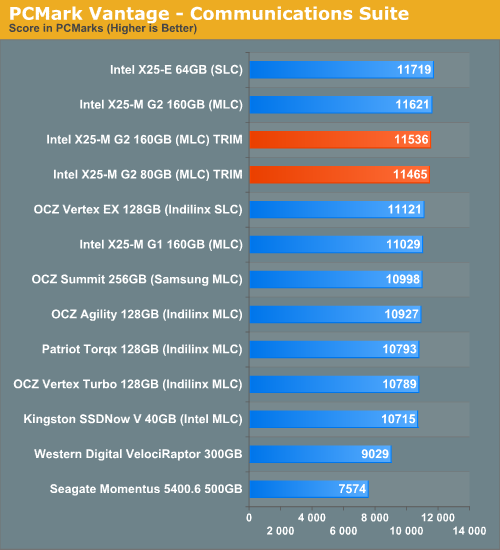
I love PCMark's Productivity test; in this test there are four tasks going on at once, searching through Windows contacts, searching through Windows Mail, browsing multiple webpages in IE7 and loading applications. This is as real world of a scenario as you get and it happens to be representative of one of the most frustrating HDD usage models - trying to do multiple things at once. There's nothing more annoying than trying to launch a simple application while you're doing other things in the background and have the load take forever.
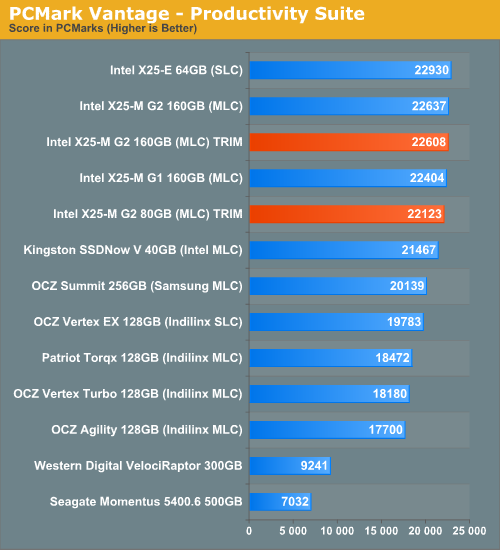
The final PCMark Vantage suite is HDD specific and this is where you'll see the biggest differences between the drives:
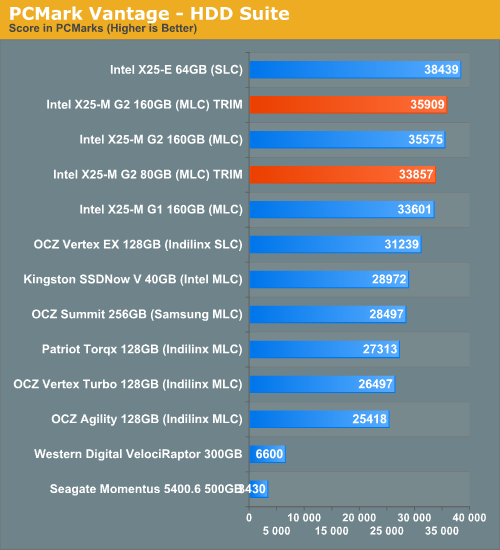










162 Comments
View All Comments
Anand Lal Shimpi - Monday, October 26, 2009 - link
Personally my pick is still the X25-M, it's had a better track record than any of the other controller makers. The problem for Intel is that Indilinx performance and feature set have both gotten a lot better.You now get TRIM, reliable performance, competitive pricing and generally everything but a super dynamic controller that's constantly trying to maximize performance. Depending on the usage scenario though, the latter may not matter as much (see my Photoshop results from the last review or the heavy trace results from this review).
My position hasn't really changed, just highlighting the importance of the issue so that hopefully Intel's value SSDs next year aren't just rebadged G2s :)
Take care,
Anand
7Enigma - Monday, October 26, 2009 - link
I think his previous review is consistent with this one. His ultimate recommendation between Intel and Indlinx drives has remained unchanged. That is, they are close enough that the size differences should be the decider for a potential buyer.As it stands, in most normal usage scenarios the statement from his last article still applies. There are very few times where you are going to be constantly tapping the 80MB/s barrier. More often you will be limited by the other SSD's lower random write speeds.
What his own benchmark can show is that in uncommon circumstances you can sway the bar back towards parity between the brands. I would argue, however, that the "heavy" usage scenario is not a practical one for an SSD. Just read his description again and look for all of the places the average user would NOT be putting that data onto an SSD:
[quote]
In this test we have Microsoft Security Essentials running in the background with real time virus scanning enabled. We also perform a quick scan in the middle of the test. Firefox, Outlook, Excel, Word and Powerpoint are all used the same as they were in the light test. We add Photoshop CS4 to the mix, opening a bunch of 12MP images, editing them, then saving them as highly compressed JPGs for web publishing. Windows 7’s picture viewer is used to view a bunch of pictures on the hard drive. We use 7-zip to create and extract .7z archives. Downloading is also prominently featured in our heavy test; we download large files from the Internet during portions of the benchmark, as well as use uTorrent to grab a couple of torrents. Some of the applications in use are installed during the benchmark, Windows updates are also installed. Towards the end of the test we launch World of Warcraft, play for a few minutes, then delete the folder. This test also takes into account all of the disk accesses that happen while the OS is booting.
The benchmark is 22 minutes long and it consists of 128,895 read operations and 72,411 write operations.
[quote]
How many people are going to be opening photoshop pictures FROM the SSD and saving them TO the SSD? Same goes with Windows Picture Viewer. Most people will have their pics on a standard large mechanical HD which makes this a moot point. Downloading large files from the net? Not a chance that would be going to my SSD! Bottom line is this is a great HELL test, but nowhere close to real-world usage.
The light-usage probably fits 90% of people 90% of the time (completely made up statistic).
With all of that said, I wish Intel's 80gig drive had closer sequencial write performance as the Indilinx drives, as it would make the decision a complete no-brainer. Looking at all the data, and planning on buying a ~$250 drive this holiday season has me very likely picking up an 80gig Intel as for me the price is about as steep as I'm willing to go for essentially a boot drive, with performance that for the majority of the time is at the top of the pack. It would be WAYYYY more difficult to decide if both Intel/Indilinx had the same drive sizes but fortunately we don't have to worry about that (at least for now....)
tynopik - Monday, October 26, 2009 - link
on page 7, all the graphs have two lines labelled 'Intel X25-M G2 80GB (MLC) TRIM'7Enigma - Monday, October 26, 2009 - link
Anand,You have listed the 80gig Intel MLC drive twice in each chart. I'm assuming one of them shouldn't say (TRIM)?
Other than that, GREAT article! Those Kingston drives look to be the PERFECT inexpensive replacement for netbooks/cheaper laptops as the performance is vastly superior to cheap mechanical HD's.
Anand Lal Shimpi - Monday, October 26, 2009 - link
That second 80GB MLC drive was actually a second set of results that didn't get pulled out. I've trimmed em out :)Take care,
Anand
fic2 - Monday, October 26, 2009 - link
"The G1 is more resillient (SIC) than the G2 when it comes to performance degradation over time since it doesn't have TRIM."Is it just me or does this sentence make no sense? I thought the whole purpose of TRIM was to make the SSD more resilient to performance degradation. Seems like it should be:
"The G1 is less resilient..."
klil - Monday, October 26, 2009 - link
The G1 is LESS susceptible to degradation than the G2, Intel compensates this by enabling TRIM on the G2.Anand Lal Shimpi - Monday, October 26, 2009 - link
Correct, my apologies for the confusing wording :)Take care,
Anand
edzieba - Monday, October 26, 2009 - link
"None of the other Indilinx manufacturers have Windows 7 TRIM support yet."Crucial has the TRIM firmware (1819) available for download for their m225 series SSDs.
TheWickerMan - Monday, October 26, 2009 - link
I was just going to post that, but you beat me to it. Here's the link for anyone else interested: http://www.crucial.com/support/firmware.aspx">http://www.crucial.com/support/firmware.aspx